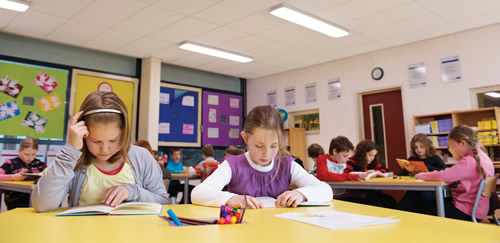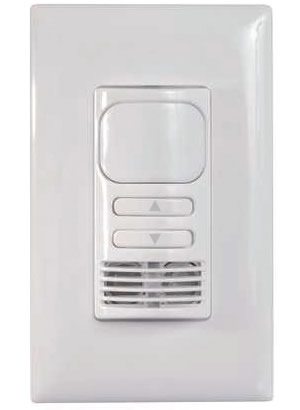New Wine in Old Bottles

PHOTO COURTESY OF SIGNIFY
There are three historical periods of electric lighting in schools, beginning in 1880 when Edison provided us with the incandescent light bulb. Nearly 140 years later, we can still find incandescent bulbs in use in some schools.
The second era began as a project to support the wartime needs of industry in the 1940’s. Fluorescent lighting provided a brighter working environment at a reduced cost for factories, office buildings, and educational facilities. The largest percentage of schools in this country still use fluorescent fixtures. During this era, an energy conservation initiative caused some schools to convert costly T12 light fixtures with magnetic ballasts to more efficient T5 lighting with electronic ballasts.
The third historical period occurred with the introduction of the Light Emitting Diode or LED. Although examples of LED technology can be found in the 1960’s, commercially available LED lighting was not practical in schools until 2009-2010. In the last 10 years, it has quickly become the preferred type of artificial lighting in schools. A trend that will no doubt continue for many years to come.
Almost every classroom built in the last 50 years includes a suspended-grid ceiling that is designed to accommodate multiple fluorescent lighting fixtures, or troffers. In order to gain acceptance of the new LED technology in school buildings, manufacturers have adapted their products to legacy equipment standards. And so, most LED lighting systems are subject to the same restrictions typically encountered with screw-in light bulbs or fluorescent fixtures. There has not been serious consideration given to eliminating the previous light fixtures and switches. Design requirements for LED lighting differ from the previous systems. Since they are not dependent on assorted types and sizes of glass bulbs, a multitude of configurations are possible. Imagine the opportunities that could be created in the learning environment if there were 50 or even 100 points of light in each classroom that could be controlled individually or grouped in zones. From their desks, teachers and/or students could create lighting levels to match the task at hand or to their individual preferences.
Our primary goal with lighting design in schools should be focused on providing an optimal learning environment in the classroom and other instructional areas. Lighting controls should no longer be simply limited to wall-mounted light switches that are on or off. Innovative school architects are making creative choices as to the positioning of school buildings and the placement of windows to capture more natural lighting in the classroom. It follows that there should also be a higher-level flexibility of controls to balance natural and artificial lighting to enhance the variety of activities, (often occurring simultaneously) throughout the space. Special consideration must be given to adjusting room light to optimize visibility of projected images on promethean boards, computer screens, and other surfaces.
Craig DiLouie, who is the education director for the Lighting Controls Association headquartered in Rosslyn, Va., describes another interesting innovation. “A more recent trend in classroom lighting control is the use of tunable-white lighting, which offers a choice of correlated color temperature (CCT) from warm (orangishwhite) to neutral to cool (bluish-white). This allows the teacher to reset the color appearance of the light to communicate activity changes and expected mood. Anecdotal research suggests there may be an influence on learning outcomes. In one study, a fifth-grade classroom in Carrollton, Texas, installed tunable-white lighting at the start of the 2016 school year and saw an improvement over the previous year’s scores in the annual state examination.”
For energy conservation the way we control lighting can be just as important as the type of lighting we use. School staff members and students are notorious for leaving lights on when spaces are unoccupied. It is quite common in schools for lighting in corridors, restrooms, and entranceways to be controlled at the breaker panel. In most cases, if we could rely on teachers, custodians, cafeteria workers, etc., to turn off the lights when they are no longer needed, we could consistently generate significant energy savings. Unfortunately, what we experience is quite the opposite. Craig DiLouie advises, “The baseline approach to lighting control is compliance with commercial building energy codes, which focus on energy-efficient design. The classroom should feature manual control, vacancy sensing, and daylight-responsive controls.”

IMAGE COURTESY OF HUBBELL LIGHTING
In control. Lighting controls should no longer be simply limited to wall-mounted light switches that are on or off. Innovative school architects are making creative choices as to the positioning of school buildings and the placement of windows to capture more natural lighting in the classroom. It follows that there should also be a higher-level flexibility of controls to balance natural and artificial lighting to enhance the variety of activities, (often occurring simultaneously) throughout the space. Special consideration must be given to adjusting room light to optimize visibility of projected images on promethean boards, computer screens, and other surfaces.
School districts have grown accustomed to the use of motion detectors, light sensors, time clocks, and most recently, digital controls. Although, complexity can often yield unintended consequences. With frequent staff turnovers, custodians or administrative personnel can lose track of switch locations. When building managers are asked, they often recount having worked in a building for several years, and in that timeframe the lights in certain areas of the building have never been turned off! A follow-up investigation by maintenance staff in those cases typically uncovers a breaker panel hiding behind a bookshelf or pins missing from a long-forgotten time clock.
Maintenance staff and custodians will see additional benefits from the shift to new lighting technology. Over the years, fluorescent lighting has required significant attention in the procurement, storage, and disposal of inoperable bulbs and ballasts. Many light fixtures are difficult to access, requiring various types of ladders, scaffolding, or lift equipment. As fluorescent lighting begins to be replaced in school buildings, there should be a decrease in the level of involvement of custodians and maintenance crews. LEDs are much easier to maintain since there are no bulbs or ballasts to replace. Since LED retrofits have occurred over a relatively short period of time, it will be important for facilities administrators to have reliable information as to what to expect in the future.
Ward Norris, vice president of Specialty Lighting LLC, in North Carolina, states, “Heat dissipation is the number one goal of a good engineer, and if you keep the LED chip under control at a reasonable ambient temperature, that chip will last 15 to 20 years. What is more likely to cause inoperable lighting is the driver. There is a cap inside of these drivers that is the weak link and it will fail at around 50,000 hours. Part of the education for facilities managers is what they will need to know when LED lighting issues start showing up in about five years. It typically doesn’t mean you have to replace the entire fixture. The driver will fail long before the diode fails and/or goes below 70 percent of its design output. Repairs may be as simple as popping in a replacement driver.” Again, as staff turns over, this is information that will be important to share.
In the foreseeable future, lighting upgrades in existing school facilities will still likely be driven by energy conservation. But while existing hardware, wiring, and switches may be used for economy, that course of action does not take advantage of the inherent flexibility of electronic lighting and digital control systems. The appropriate placement and control of lighting can be a significant enhancement to the learning environment offering educators and students more control and flexibility than ever before.
This article originally appeared in the School Planning & Management April/May 2019 issue of Spaces4Learning.
About the Authors
Andrew LaRowe is president of EduCon Educational Consulting located in Winston Salem, N.C. He can be reached at alarowe@educonenergy.com
Mike Raible is founder and CEO of The School Solutions Group in Charlotte, N.C., and the author of "Every Child, Every Day: Achieving Zero Dropouts Through Performance-Based Education". He can be reached at mkraible@theschoolsolutionsgroup.com.